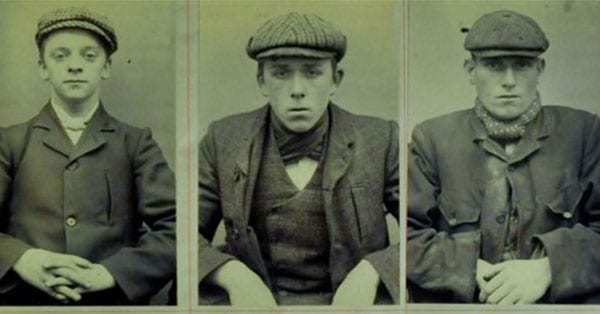The old saying suggests that there is ‘strength in numbers’. Certainly, when you combine a group of criminals into a gang, they become exponentially more dangerous. As well as terrorizing and intimidating people, it becomes difficult for police to shut a gang down once it becomes large enough. This is evident in the size of some of the gangs on this list. Overall, I look at five notorious street gangs, two of which are still operating today.

1 – The Peaky Blinders
Although the TV show has likely ensured this gang is now known by a few people, I include them because most people probably don’t know the real story of the gang. The Peaky Blinders were a gang of youths that operated in Birmingham at the end of the 19th century and in the early 20th century. They gained their name because members wore flat caps with peaks. The notion that the name comes from their tendency to stitch razor blades in the peaks of their caps is probably false. However, the peak of their caps was extremely hard so head butting someone on the nose while wearing one would probably cause the victim to have temporary blindness.
Historians continue to debate whether the Peaky Blinders were a single gang or an entire subculture of thieves. It’s likely that the gang was a single entity in Birmingham, but the term became a generic one in decades to come. While the TV show features Tommy Shelby as the leader of the gang, no such person actually existed. Prominent gang members included Harry Fowler, Stephen McHickie, Ernest Bayles, Thomas Gilbert, and David Taylor who was arrested for carrying a gun aged 13.
When West Midlands Police dug up the records of leading Peaky Blinders members, they were surprised to learn that despite their reputation for committing terrible crimes, many members were arrested for minor charges. For example, McHickie was caught for breaking into a draper’s shop while Fowler and Bayles were arrested for bike theft. The gang made its money through protection rackets, illegal betting, and the city’s black market.
In reality, while the Peaky Blinders were vicious thugs, their crimes pale in comparison with the activities of the rest of the gangs on this list. Incidentally, while the TV series is based in the 1920s, the real gang began its operations in the 1880s. By the 1920s, the Birmingham Gang, led by Billy Kimber, emerged as the main criminal player in the city and soon, it became among the most dangerous gangs in the UK.

